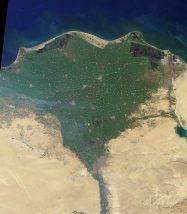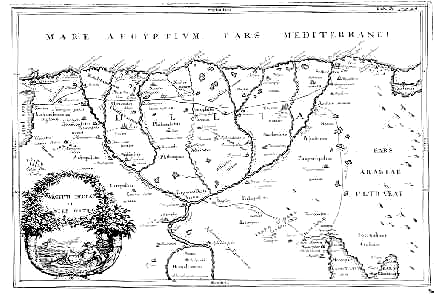from: Israel Finkelstein / Neil A.
Silberman: The Bible unearthed. Archeology's New
Vision of Ancient Israel and the Origin of Its Sacred
Texts; The Free Press, a division of Simon &
Schuster, Inc., 2001; German edition has got the title
"No trombones before Jericho" (orig. German: "Keine
Posaunen vor Jericho"): edition C.H.Beck oHG, Munich
2002;
From the German version "Keine
Posaunen vor Jericho" of DTV, Munich 2004, second
edition of 2005. All page indications refer to the
German version. I hope the page numbers are not very
different.
The prescription about Jacob
according to the outdated Bible
OT claims:
-- Jacob is said having had 12 sons
-- these 12 sons of Jacob are said having fled from a
famine to Egypt, and Jacob's testament is said having
rated the son Judah over all other (p.20)
-- Egypt is said having been full of Jews (Exodus 1,7)
-- a Pharaoh who did not know anything of Josephs history
is said having claimed that the Jews could reveal Egypt to
it's enemies
-- as a reaction the Pharaoh is said having enslaved all
Jews, and the Jews are said having built as slaves the
towns of the kings Pithom and Ramses
-- as enslaved Jews the Jews are said not having had
children any more (Ex. 1,12)
-- and by this the slavery is said having been extended to
heavy brickworks and heavy agriculture (Ex. 1,14)
-- under the alleged conditions of slavery the 12 sons of
Jacob in Egypt are said having formed one nation (p.62).
The
documents speak: the extreme poetry of Egypt historian
Manetho in 3th century B.C. with a dreadful Hyksos
dynasty
Egypt poet Manetho is writing texts with descriptions of
invasions from the East:
-- Manetho is stating immigrants in the eastern part of
the Nile Delta who have an extraordinary success, and he
claims that these immigrants from the East (named
"Hyksos", "rulers from abroad", he translates it as "kings
of shepherds") are a national tragedy for Egypt as if
there had been an invasion from the East (p.67)
-- these hyksos are said having settled in the delta in
the town of Avaris
(later Tell ed-Daba)
and had founded an own dynasty governing in a dreadful way
over Egypt for 500 years (p.67-68)
-- prescribing this invasion Manetho also is commemorating
the latest invasions from Assyria, Babylonia and Persia in
Egypt during 7th and 6th century B.C. (p.69).
So, there are new doubts what is true or not with this
Manetho. Because of this there has to be more
investigation.
The "scholars" - the Hyksos
of the "mid Bronze Age"
For a long time the scholars rated the Hyksos as the kings
of 15th dynasty of Egypt 1670-1570 B.C. (p.68), compared
with Europe this would be in the mid Bronze Age (p.78). In
mid Bronze Age around 1600 B.C. Canaan (today's Israel
Palestine) is a wealthy society (p.91).
But how should ruled a foreign folk from Canaan in Egypt?
This question has to be cleared.
Archaeological proof for the
Jacob case
The Nile Delta is a center of
safe nutrition during dry periods in Canaan - and there
was constant immigration
The documents and archeology confirm a steady immigration
from Canaan to Egypt to the eastern part of the Nile Delta
(p.65). This immigration is a very old rhythm of the
Middle East performed in all times (p.67). Egypt always
was the spot of rescue and safety when there was a dry
season or war in Canaan (p.65), because the flood of the
Nile in Egypt was a guarantee for a good harvest every
year, in case of doubt with irrigation. Add to this Egypt
state had store houses for the case of dry seasons (p.66).
During Bible times the Nile Delta was parted in 7 arms and
had a bigger territory than today with only two arms of
the river. In Bible times the eastern Delta arm of the
Nile for example arrived the north western Sinai.
And corresponding to this also the irrigation system was
more expanded. Excavations can prove this (p.66).
The Nile Delta of Bible times and of
today
|

Nile Delta in Pharaoh's times: many arms, Memphis,
Avaris, Canaan

 Nile Delta
of today: only 2 arms have left, and Suez Channel Nile Delta
of today: only 2 arms have left, and Suez Channel
|

Nile Delta in 1706: there are 4 or 5 arms
|
|
The immigrants in the eastern
Nile Delta - making career in Egypt administration
Probably these immigrants were nomads and farmers of
Canaan (p.66-67), eventually also economic refugees or
merchants. They had their salary with jobs as landless
workers. Add to this Canaan war prisoners were settled in
eastern Nile Delta, when Egypt executed a punitive action
in Canaan, and these war prisoners had to work in the
Egypt temple plants. Some of the immigrants succeeded with
their career and got posts of government, were soldiers
and priests. Joseph who is said having sent with a caravan
to Egypt would be not a singular case, but this would be
only the most known case of many cases (p.67).
Archeology with seals,
inscriptions and texts
-- in the Nile Delta of these times (which is situated
more in the East than today) archeology finds inscriptions
and seals with names of Canaanite origin (p.69)
-- latest excavations confirm the Canaanite origin of the
Hyksos rule and an immigration step by step, but a sudden
military invasion as it is claimed by the Egypt extreme
poet Manetho is not confirmed by archeology (p.69)
-- the today's Tell
ed-Daba in the eastern Nile Delta of these times
is identified as Aurais
/ Avaris, the former capital of the Hyksos rulers
(p.69)
-- archaeologists can prove that since 1800 B.C. appr.
there was a Canaanite influence on the eastern Nile Delta
enforcing with ceramics, architecture and graves. Since
1670 B.C. Avaris (today's Tell ed-Daba) was growing up to
the 15th dynasty and was a huge town, mainly in Canaanite
style. And there was a peaceful takeover of power to the
Canaanites, because there are no fire traces or ash layers
in the hill of ruins (p.69).
The documents speak: Pharaoh
Ramses did not exist yet - and not either a town of
Ramses
A name "Ramses" for a town which the Jews are said having
constructed in 15th century B.C. during the alleged time
of a certain Jacob is not possible in this 15th century
B.C., because first Pharaoh named "Ramses" comes only in
1320 B.C. on it's throne, only over 100 years after the
traditional date of the Bible (p.70).
Egypt sources report about a construction of the town
Pi-Ramesse ("House of Ramses", "Palace of Ramses") in the
Nile Delta under king Ramses II (1279-1213 B.C.), whereas
it seems that Semites were the workers (p.71).
[If this was a slavery or not is not said by Finkelstein /
Silberman].
Evidence:
Later invasions of the Assyrians, Babylonians and Persians
provoking anxiety in Egypt with reproaches to the
Israelites
OT claims:
The immigrants from Canaan are confronted
with the reproaches by Egypt (Genesis 42,9) that they would
be spies investigating where "the country is open", and by
this all Jews should be enslaved (p.81).
The documents say: Such
reproaches of espionage have no reason before 7th century
B.C., but after the invasions of Assyria, Babylonia and
Persia in Egypt and in Mid East in 7th and 6th century B.C.
such reproaches of espionage would have their reasons
(p.81).
Conclusion
The contradiction about a steady
immigration to Egypt because of dry seasons and wars and the
contradictions about the fear of invasions and espionage in
Egypt are provoking to put in doubt the events with the 12
sons of Jacob in Egypt. The evidence indicates that the
history of Jacob was written in the 7th century B.C. only.




 Nile Delta
of today: only 2 arms have left, and Suez Channel
Nile Delta
of today: only 2 arms have left, and Suez Channel